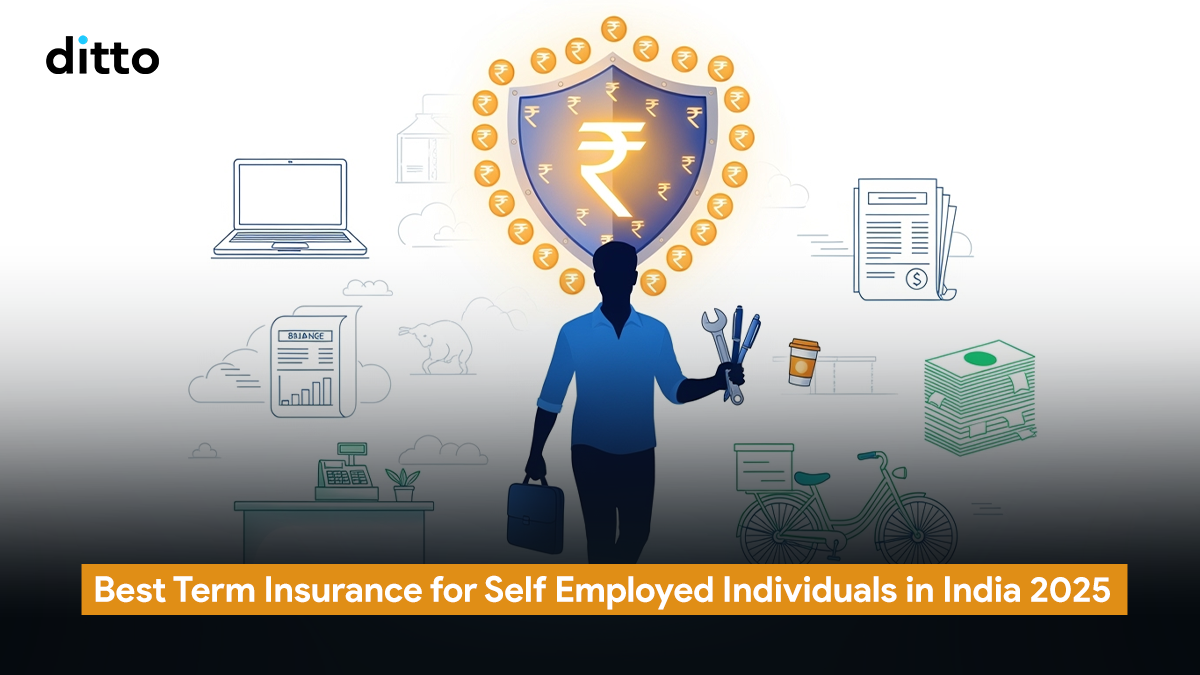| How Self-Employed Individuals Can Secure Term Insurance in India? Term insurance for self-employed individuals in India is harder to get approved than for salaried people because insurers demand proof of stable, verifiable income in the absence of salary slips. Approval depends on documents like ITRs, GST returns, audited financials, and bank statements, with cover usually capped as a multiple of declared income. Fluctuating earnings, recent business setup, or poor documentation can reduce eligibility, while consistent filings, clear bank trails, and realistic cover requests improve approval chances. |
Getting term insurance as a self-employed professional in India isn’t as straightforward as it is for salaried folks. Unlike employees with steady payslips, freelancers, consultants, and business owners are often asked for proof of income and financial stability that’s not always easy to produce.
At Ditto, we review thousands of applications every year, including many from self-employed clients who face extra scrutiny from insurers. We’ve seen first-hand how missing documents or fluctuating income can slow down or even derail approvals.
That’s why this guide doesn’t just list plans. It breaks down how insurers assess your risk profile, the exact proofs you’ll need to keep ready, and the strategies that actually improve policy approval odds.
Your next step? Get your documents in order and match them with the right plan format. If you’re still weighing options, chat with a Ditto advisor to find a policy that best fits your needs.
Best Term Insurance Plans for Self-Employed & Non-salaried Individuals in India (2025)
Choosing the right Term Insurance for Self Employed means looking beyond premiums since insurers weigh your income stability, documents, and business history before approval.
We’ve shortlisted these best self employed term insurance plans for 2025 based on how friendly they are to self-employed applicants.
| Plan | Documents Required | Drawbacks |
|---|---|---|
| HDFC Life Click2Protect Supreme | - ITRs for last 3 years with CA-certified income computation - Underwriter may request audited P&L and balance sheets for last 3 years |
- Higher premiums |
| ICICI Prudential iProtect Smart Plus | - Latest 3 years ITRs with computation of income - Bank statements - Form 26AS |
- Waiver of premium rider not yet launched |
| AMLI Smart Term Plan Plus | - ITRs for last 2 assessment years - Audited business accounts for last 3 years - Shareholding patterns/partnership deed - P&L account & balance sheet - Unearned income excluded |
- No life stage coverage increase - No inflation-linked top-up |
| BALIC E-Touch II | - For SA < ₹1 Cr: Latest 2 years ITRs - For SA > ₹1 Cr: Latest 3 years ITRs with computation of income |
- No waiver of premium on critical illness - Less recognized brand |
| TATA AIA Sampoorna Raksha Promise | - ITRs and CA-certified computation for last 3 years - Audited P&L & balance sheets for last 2 years - Average income considered |
- Covers only 40 illnesses under CI rider (vs. 60+ elsewhere) - Rates fixed for 5 years only - Post-sales support can be slower |
| Did You Know? Some newer self employed term insurance plans like the Bajaj iSecure II & ICICI iProtect Super now offer cover without traditional income proofs like ITRs, Computation of income or GST returns. Instead, insurers may use your credit score, digital spending patterns, or other income surrogate (like avg bank balance, investment portfolios & Car IDV) data to assess eligibility. This can be a huge win for entrepreneurs or freelancers with low declared income but strong financial discipline. Just keep in mind: these plans have higher premiums, limited cover of up to ₹1crore and stricter medical underwriting if any risk flags pop up. |
Key Riders for Term Insurance for Self Employed & Non-salaried individuals
When you’re self-employed, your income isn’t always guaranteed, but your financial responsibilities usually are. That’s why the right term insurance for self-employed individuals shouldn’t just provide a plain death cover. It needs riders/add-ons that protect you while you’re still alive and earning.
Here are the must-have riders for term insurance protection for self-employed in 2025:
Key Riders for Self-Employed & Non-salaried individuals Term Insurance
Self-employed income is often unpredictable, but financial responsibilities remain. The right riders can protect you while keeping your policy active.
- Critical Illness Rider: Pays a lump sum for serious illnesses (cancer, heart attack, stroke) to cover treatment or business/family expenses. Tip: Aim for coverage worth 1–3 times your annual income.
- Waiver of Premium Rider: Keeps your policy active if you can’t pay premiums due to illness or disability. Essential for self-employed individuals without employer benefits.
- Disability Cover (Accidental Total & Permanent Disability – ATPD): Provides a payout if you permanently lose the ability to work. Unlike the base term plan, you cannot choose between payout options — the structure (lump sum or monthly) is fixed by how the insurer has designed the rider, and you can only select it from the same insurer you buy your base policy from. These riders are offered by only a few insurers, so availability is limited.
- Lump sum (e.g., TATA AIA Sampoorna Raksha Promise’s ATPD Rider): Best for clearing debts, modifying your home to accommodate the disability, or starting a new venture.
- Monthly income (e.g., HDFC Click2Protect Supreme’s Income Benefit Rider): Replaces regular earnings to support your family’s ongoing expenses.
If your work is physical, lump sum payouts offer flexibility to pivot careers. If you run a consultancy or service business, monthly income payouts ensure steady cash flow.
Note: As per IRDAI norms, premiums for non-health-related riders (like accidental death benefit) cannot exceed 30% of the base policy premium. However, health-related riders such as Critical Illness (CI), Waiver of Premium (WOP), and Disability benefit can together push the rider premium up to 100% of the base premium. If these limits are breached, the insured must either reduce the rider cover or increase the base sum assured so that the higher rider premium can be accommodated.
For those seeking term insurance for self employed, building the perfect plan with the right riders is only half the battle; the other half is ensuring you can pay consistently. That’s where the Limited Pay Option helps.
How Limited-Pay Term Insurance Works for Self-Employed & Non-salaried individuals?
Even if you build the perfect plan with all the right riders, it won’t help if you can’t keep paying premiums for decades. Limited Pay ensures you finish payments during your best earning years and remove the risk of your policy lapsing later in life.
Benefits:
- Pay during strong income periods, secure cover for later years.
- Future-proof protection despite income drops or early retirement.
- Limited pay can cost less than spreading payments over decades (Ignoring inflation and opportunity cost).
- Peace of mind: no risk of losing coverage during cash-flow crunches.
IRDAI Paid-Up Checkpoint: Once you’ve paid premiums for at least two full years (or one-fourth of the policy term, whichever is earlier), your policy secures a guaranteed paid-up value, even if you stop making payments.
You can learn more about how premium paying term works in life insurance and why it’s especially useful for self-employed professionals looking to lock in cover without long-term payment stress.
Ditto’s Tips for Self-Employed & Non-salaried individuals Term Insurance Buyers
Insurers scrutinise self-employed applicants more because income is harder to verify. The fix? Solid documentation and smart planning.
1. Maintain Strong Income Proofs
When applying for term insurance for self employed, buyers need to:
- File 2–3 years of ITRs showing income under “Income from Business/Profession.”
- Get CA-certified income computation.
- Use Form 26AS for tax credit verification.
2. File Accurate Income Tax Returns (ITRs)
Many self-employed applicants unknowingly sabotage their eligibility by showing unrealistically low net income in their ITRs. Insurers calculate your maximum cover based on your net profit after deductions, not your total revenue.
Example:
- Declared income ₹5 lakh → Eligible cover may be ₹50 lakh–₹1 crore.
- Declared income ₹12 lakh → Eligible cover could be ₹2–₹3 crore or more.
In short, the higher your declared income, the higher the cover eligibility. This also means under-reporting to save tax can cut your eligible cover by crores.
| Did you know? Insurers often decide your maximum term cover using your average income over the past 2–3 years, multiplied by a fixed factor (usually 20–25× for life cover). Example: if you earned ₹7 L in 2022, ₹8 L in 2023, and ₹9 L in 2024, your 3-year average income is ₹8 L. If the insurer applies a 25× multiplier, your maximum eligible cover would be: ₹8 L × 25 = ₹2 crore. |
3. Keep Your Business Documents Handy
For self-employed individuals, your ITRs and CA-certified computation of income for the last 2–3 years are the primary documents insurers will review first. Underwriting delays often happen when supplementary proofs like GST returns, trade licenses, business registration certificates, and recent bank statements are requested. This is why having both primary and additional documents ready upfront can speed up the process significantly.
4. Pick the Right Type of Term Plan
Not all term plans are built the same. Some work better for volatile incomes, some offer flexibility to adjust cover, and others let you exit early if you no longer need protection. You can explore the different formats here: types of term insurance and see which fits your business and life stage best.
5. Be Transparent About Income Fluctuations
Since self-employed income can vary year to year, proactively explain any dips or spikes in your earnings to the insurer. Also explain new client onboarding, business expansion, or one-time expenses so underwriters can assess your risk more accurately and reduce the chances of rejection or premium hikes.
Expect underwriters to review 6-12 months of your bank statements for large or frequent deposits made just before application; patterns flagged as “window dressing” (temporary or artificial deposits made to inflate your income), can trigger extra scrutiny from insurers.
6. Work with an Experienced Advisor
When applying for term insurance for self employed, an advisor can help you pick the right insurer, present your documents correctly, and clarify issues with underwriters if anything gets stuck. This ensures clear communication and reduces delays or rejections.
Why Talk to Ditto for Your Insurance?
At Ditto, we’ve assisted over 7,00,000 customers with choosing the right insurance policy. Why customers like Ajay below love us:
✅No-Spam & No Salesmen
✅Rated 4.9/5 on Google Reviews by 12,000+ happy customers
✅Backed by Zerodha
✅100% Free Consultation
You can book a FREE consultation. Slots are running out, so make sure you book a call now!
Final Thoughts
As a self-employed professional, your term insurance approval depends less on premiums and more on how well you prove income stability and financial discipline. Traditional proofs like ITRs can feel like a hurdle, but newer plans that rely on credit scores and digital footprints open alternate routes to coverage.
To secure lasting protection, finish premiums early with a Limited Pay Option and strengthen your policy with essential riders—Critical Illness, Waiver of Premium, and Disability Cover. Together, these keep your cover active even if your earnings fluctuate.
Your next step? Get your documents in order and match them with the right plan format. If you’re still weighing options, chat with a Ditto advisor to find a policy that best fits your needs.
FAQs – Term Insurance for Self Employed & Non-salaried individuals
Can I get term insurance if I don’t have traditional income proofs like ITRs?
Yes. A new breed of term insurance for self employed plans such as Bajaj Allianz Life iSecure II and ICICI iProtect Super assess eligibility using credit scores, digital spending data, and other income surrogates instead of ITRs or GST returns. They’re useful if your actual earnings are higher than your declared income, but expect slightly higher premiums, limited coverage and stricter underwriting.
What documents are required to buy term insurance for self employed individuals?
Most insurers require:
- ITRs for the last 2–3 years with CA-certified computation of income
- GST registration, trade license, or professional license
- Bank statements showing consistent income flow
- Form 26AS for tax credit verificationOnly income from “Business/Profession” is considered; capital gains, F&O Income, commission based or interest income won’t count towards eligibility.
My business is new. Can I still get term insurance?
Yes, but expect more scrutiny. Most insurers prefer at least 2–3 years of ITRs showing consistent income. If your business is very new and income proof is weak, you may:
- Qualify for a lower cover initially.
- Need to apply with insurers offering simplified underwriting options (like Bajaj Isecure II or ICICI Iprotect super plan).
- Increase your cover later when your business income stabilises.
What is the eligibility criteria for self-employed to get term insurance?
For self-employed individuals, term insurance eligibility mainly depends on proving stable, taxable income and business continuity.
- Age: Typically 18–60 (sometimes 65) years at entry (varies by insurer). Ditto recommends to opt till ages 60-70 only to make it cost effective and till then most people have no dependents anymore and are financially stable.
- Income Proof: 2–3 years’ ITRs, GST returns, audited financials, CA certificate, and bank statements.
- Business Continuity: At least 2–3 years of stable business or professional practice preferred.
- Business Proof: Documents like GST registration, Udyam certificate, partnership deed, or incorporation certificate.
- Sum Assured: Usually capped at 10–15× of declared annual income.
- Health & Lifestyle: Standard medical tests, plus checks on smoking, drinking, or hazardous occupations.
- Education: Graduate usually required; 12th pass accepted with high income; 10th pass rarely, only with very high income.
Can I get term insurance if most of my income is in cash?
It’s possible, but difficult. Insurers prefer traceable income (via bank statements, GST filings, ITR). If you primarily earn in cash, try to deposit regularly in your bank account and file ITRs reflecting that income before applying.
Should I buy term insurance under the Married Women’s Property Act (MWPA)?
If you have unsecured loans (especially from informal lenders), buying your term insurance for self employed under MWPA ensures the payout goes directly to your spouse/children and cannot be claimed by creditors. But please note that once the beneficiary is set under the act, it cannot be changed later on.
What if my income type changes from salaried to self-employed (or vice versa)?
Your term insurance cover is fixed at the time of application and won’t change if you shift between salaried and self-employed.
Tip: If you plan to start a business and expect irregular income, secure a higher cover now while income proof is easier.
My term insurance application was rejected due to low income proof. Can I reapply?
Yes. A financial rejection isn’t permanent. Once your documents improve and your declared income meets insurer requirements, you can reapply. This is different from a medical rejection, which can be harder to overcome.
What happens to term insurance for self employed individuals if premiums can’t be paid due to irregular income?
Some plans, like HDFC Click2Protect Supreme and Bajaj E-Touch II, have a Cover Continuation Benefit (premium break option) that lets you pause payments for up to one policy year without losing cover or incurring interest/penalty. Ideal for self-employed individuals facing temporary cash-flow issues. Note that the paused years' premiums must be paid along with the next year's premiums.
Last updated on:










